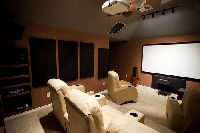
Building a home theater room takes some planning and the right equipment
So, you’re interested in building a home theater room? The wailing baby, the horde of 13-year-olds kicking your seat for two straight hours, and the man letting his wife know by cell what was transpiring in your picture.
What could it possibly be that made you want to build your own personal viewing area in the comfort of your own home?
For those looking to upgrade to a real movie-going experience right in your own home, look no further. With technological advances as they are, these personal theater set-ups are no longer just for the Wahlberg’s of the world.
Choosing Your Location
Where to set it up? There will be sound concerns, so here are a few options that could work:
- A wing next to the family room
- Converting an unused bedroom
- Inputting your new area in an upstairs open space right above the living room
According to HGTV.com, the perfect space for your new addition should be around 20 feet long by 13 feet wide. The isolation factor is definitely important for sound; as well, you don’t want to disturb the other inhabitants of the abode either.
~
The Construction Process
For those who aren’t quite as technically proficient as they need to be, one can find building contractors in your area at HomeTheaterCompanies.com. They can streamline the process of creating your new space and do so without you needing to learn about wiring, lighting, equipment placement, noise reduction, and more.
This Hometheater site offers a truly mind blowing and in-depth amount of information on the overall process — All on a budget that can work for many families. It’s a highly technical and thoroughly informative 7-page manual that covers every facet of creating a truly memorable entertainment area.
Here are a few quick facts to get prospective builders in the right mindset:
- A 7.1 surround sound system can be used; this includes one subwoofer and seven channel speakers
- You’ll need only two cables in order to pre-wire the projection system: an HDMI cable for high definition to the projector and a CAT5 control wire in order to access the projector with a RF remote
- You may need to install recessed lighting in your ceiling, as well as sconces along the side walls; this will create a true-to-life movie-going experience for friends and family
- You’ll need to install drywall, sound barriers, and eventually set up your sound and video systems. Projector mounts can be hung from the ceiling for maximum efficiency
- In an area which runs 20 by 13 feet, HGTV offers that the screen size should run 110-120 inches for optimal viewing pleasure
- Products like a Blu-ray player, PC, game console, or a cable/satellite feed may be connected to your receiver; the speakers and projector will connect to this receiver when everything is finished
What about Seating?
Two rows of seating will fit perfectly in your 20 by 13 space; like the real multiplexes, try elevating your back row seats in order to give viewers the best possible vantage point.
Thus, building a home theater room can be a complex endeavor for the uninitiated. Try using HomeTheaterCompanies.com to find contractors in your area. If you’d like to take on the project yourself, head over to HGTV or Hometheater.com in order to get the most in-depth and helpful information on the net.
As well, the website Monoprice offers how-to’s on a variety of home theater categories. No matter which route you take, the end result will be a space in which you can sit, relax, and let the power of film take you to another time and place — All in the comfort of your own home!
Resources:
HGTV.com: How to Build a Home Theater.
Hometheater.com: Design the Ultimate Home Theater — On a Budget.
Above photo attributed to gsloan
